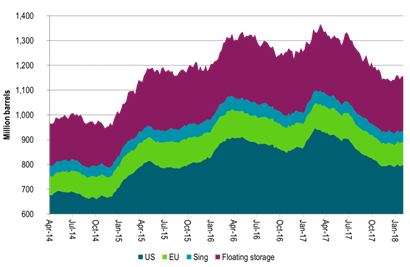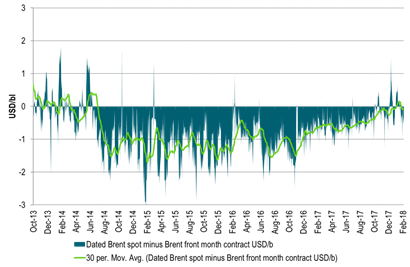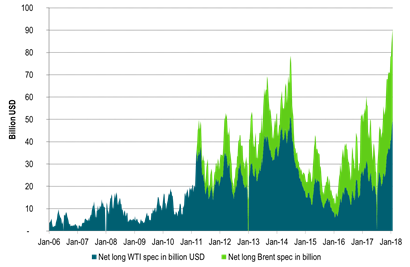Analys
Overdue correction on the back of equity sell-off and rising US crude production and rig count rise

 Oil prices experienced a long overdue price correction last week as Brent crude fell back 2.8% to $68.58/bl along with a broad based sell-off in equities. Bearish oil stats showing US crude production rose above 10 m bl/d in November and a fraction from all time high was clearly bearish news though the market did not seem to care too much about it when it was released. US oil players adding 6 rigs last week and 18 ytd probably created bearish concern at the end of the week along with the accelerating sell-off. We expect the US EIA to revise its forecasted US crude oil production significantly higher in tomorrow’s STEO report. That will be the 5th revision in five months and it is probably not done with upwards revisions until it reaches an average 2018 production forecast of 10.7 m bl/d. A combination of the latest STEO and DPR reports indicates that US crude oil production is standing at 10.41 m bl/d now in February.
Oil prices experienced a long overdue price correction last week as Brent crude fell back 2.8% to $68.58/bl along with a broad based sell-off in equities. Bearish oil stats showing US crude production rose above 10 m bl/d in November and a fraction from all time high was clearly bearish news though the market did not seem to care too much about it when it was released. US oil players adding 6 rigs last week and 18 ytd probably created bearish concern at the end of the week along with the accelerating sell-off. We expect the US EIA to revise its forecasted US crude oil production significantly higher in tomorrow’s STEO report. That will be the 5th revision in five months and it is probably not done with upwards revisions until it reaches an average 2018 production forecast of 10.7 m bl/d. A combination of the latest STEO and DPR reports indicates that US crude oil production is standing at 10.41 m bl/d now in February.
More US crude oil production in 2018 is what the US STEO report will say tomorrow
Last week the US EIA released actual US crude oil production for Nov 2017. It came in at 10.038 m bl/d, just a fraction from the all-time high in 1970 of 10.044 m bl/d. The November data was 170 k bl/d higher than what EIA’s estimated in the Jan-17 STEO report which estimated it to be 9.87 k bl/d.
Last week’s data point came as little surprise to us. This is because when you look at the monthly US EIA STEO report and the monthly US EIA DPR report it is evident that the two reports are out of sync. It shows that the strong rise in US shale oil production which is spelled out very clearly in the DPR report is not reflected in the US STEO report. Neither when it comes to the latest months back to November nor the forward looking months over the coming year.
Last week’s upwards revision of 170 k bl/d to 10.038 k bl/d may seem fickle in the big scheme of things. But when you see that reason is the lack of synchronization between the STEO and the DPR reports then the error becomes systematic rather than just noise. Then one can take into account US shale oil production growth also for December, January and February. The DPR report spells out clearly that shale grew and will grow by 311 k bl/d during those three months. In addition is 60 k bl/d of production growth in GoM and Alaska. Thus a total gain of 371 k bl/d on top of the November data.
This brings us to the fact that US crude oil production is highly likely standing at 10.41 m bl/d now in February 2018. In perspective the US EIA STEO report forecasts US crude oil production to average 10.27 m bl/d in 2018. For February alone we are already 136 k bl/d above that (based on DPR data). We are also 359 k bl/d above the EIA’s February production estimate (STEO report) of 10.05 m bl/d.
All told the US monthly STEO report which is the official US crude oil production forecast is lagging US shale oil production growth both on a 2-3 months backward looking basis (vs the DPR report) as well as on a forward looking basis. After all the US EIA DPR report is showing that US shale oil production is now is growing at more than 100 k bl/d per month. Well completions are still rising and since the start of the year there has been an additional 18 drilling rigs activated in the US oil space.
Unless oil prices collapses there is little reason to believe that US shale oil production will not continue to grow by 100 k bl/d per month all through 2018 (as it has done since July 2017) rather than the 41 k bl/d/month estimated in the January EIA STEO report. We expect another solid revision higher for 2018 US crude oil production projection by the US EIA when it publishes its monthly STEO report tomorrow. It will be the 5th upwards revision in 5mths and it won’t be the last until they reach a forecast of around 10.7 to 10.8 m bl/d for 2018.
We view the current sell-off as a very good buying opportunity for forward crude contracts. Brent Dec-2020 now trades at $57.9/bl = $54.6/bl if inflation adjusted.
Chart 1: Weekly oil inventory data rising marginally rather than declining steeply
Chart 2: Dated Brent crude has shifted to a discount to Brent 1mth rather than a premium
Chart 3: Net long speculative allocation to oil at all-time-high
That’s a painful position as the market now sells off
Kind regards
Bjarne Schieldrop
Chief analyst, Commodities
SEB Markets
Merchant Banking
Analys
Tightening fundamentals – bullish inventories from DOE

The latest weekly report from the US DOE showed a substantial drawdown across key petroleum categories, adding more upside potential to the fundamental picture.

Commercial crude inventories (excl. SPR) fell by 5.8 million barrels, bringing total inventories down to 415.1 million barrels. Now sitting 11% below the five-year seasonal norm and placed in the lowest 2015-2022 range (see picture below).
Product inventories also tightened further last week. Gasoline inventories declined by 2.1 million barrels, with reductions seen in both finished gasoline and blending components. Current gasoline levels are about 3% below the five-year average for this time of year.
Among products, the most notable move came in diesel, where inventories dropped by almost 4.1 million barrels, deepening the deficit to around 20% below seasonal norms – continuing to underscore the persistent supply tightness in diesel markets.
The only area of inventory growth was in propane/propylene, which posted a significant 5.1-million-barrel build and now stands 9% above the five-year average.
Total commercial petroleum inventories (crude plus refined products) declined by 4.2 million barrels on the week, reinforcing the overall tightening of US crude and products.


Analys
Bombs to ”ceasefire” in hours – Brent below $70

A classic case of “buy the rumor, sell the news” played out in oil markets, as Brent crude has dropped sharply – down nearly USD 10 per barrel since yesterday evening – following Iran’s retaliatory strike on a U.S. air base in Qatar. The immediate reaction was: “That was it?” The strike followed a carefully calibrated, non-escalatory playbook, avoiding direct threats to energy infrastructure or disruption of shipping through the Strait of Hormuz – thus calming worst-case fears.

After Monday morning’s sharp spike to USD 81.4 per barrel, triggered by the U.S. bombing of Iranian nuclear facilities, oil prices drifted sideways in anticipation of a potential Iranian response. That response came with advance warning and caused limited physical damage. Early this morning, both the U.S. President and Iranian state media announced a ceasefire, effectively placing a lid on the immediate conflict risk – at least for now.
As a result, Brent crude has now fallen by a total of USD 12 from Monday’s peak, currently trading around USD 69 per barrel.
Looking beyond geopolitics, the market will now shift its focus to the upcoming OPEC+ meeting in early July. Saudi Arabia’s decision to increase output earlier this year – despite falling prices – has drawn renewed attention considering recent developments. Some suggest this was a response to U.S. pressure to offset potential Iranian supply losses.
However, consensus is that the move was driven more by internal OPEC+ dynamics. After years of curbing production to support prices, Riyadh had grown frustrated with quota-busting by several members (notably Kazakhstan). With Saudi Arabia cutting up to 2 million barrels per day – roughly 2% of global supply – returns were diminishing, and the risk of losing market share was rising. The production increase is widely seen as an effort to reassert leadership and restore discipline within the group.
That said, the FT recently stated that, the Saudis remain wary of past missteps. In 2018, Riyadh ramped up output at Trump’s request ahead of Iran sanctions, only to see prices collapse when the U.S. granted broad waivers – triggering oversupply. Officials have reportedly made it clear they don’t intend to repeat that mistake.
The recent visit by President Trump to Saudi Arabia, which included agreements on AI, defense, and nuclear cooperation, suggests a broader strategic alignment. This has fueled speculation about a quiet “pump-for-politics” deal behind recent production moves.
Looking ahead, oil prices have now retraced the entire rally sparked by the June 13 Israel–Iran escalation. This retreat provides more political and policy space for both the U.S. and Saudi Arabia. Specifically, it makes it easier for Riyadh to scale back its three recent production hikes of 411,000 barrels each, potentially returning to more moderate increases of 137,000 barrels for August and September.
In short: with no major loss of Iranian supply to the market, OPEC+ – led by Saudi Arabia – no longer needs to compensate for a disruption that hasn’t materialized, especially not to please the U.S. at the cost of its own market strategy. As the Saudis themselves have signaled, they are unlikely to repeat previous mistakes.
Conclusion: With Brent now in the high USD 60s, buying oil looks fundamentally justified. The geopolitical premium has deflated, but tensions between Israel and Iran remain unresolved – and the risk of missteps and renewed escalation still lingers. In fact, even this morning, reports have emerged of renewed missile fire despite the declared “truce.” The path forward may be calmer – but it is far from stable.
Analys
A muted price reaction. Market looks relaxed, but it is still on edge waiting for what Iran will do

Brent crossed the 80-line this morning but quickly fell back assigning limited probability for Iran choosing to close the Strait of Hormuz. Brent traded in a range of USD 70.56 – 79.04/b last week as the market fluctuated between ”Iran wants a deal” and ”US is about to attack Iran”. At the end of the week though, Donald Trump managed to convince markets (and probably also Iran) that he would make a decision within two weeks. I.e. no imminent attack. Previously when when he has talked about ”making a decision within two weeks” he has often ended up doing nothing in the end. The oil market relaxed as a result and the week ended at USD 77.01/b which is just USD 6/b above the year to date average of USD 71/b.

Brent jumped to USD 81.4/b this morning, the highest since mid-January, but then quickly fell back to a current price of USD 78.2/b which is only up 1.5% versus the close on Friday. As such the market is pricing a fairly low probability that Iran will actually close the Strait of Hormuz. Probably because it will hurt Iranian oil exports as well as the global oil market.
It was however all smoke and mirrors. Deception. The US attacked Iran on Saturday. The attack involved 125 warplanes, submarines and surface warships and 14 bunker buster bombs were dropped on Iranian nuclear sites including Fordow, Natanz and Isfahan. In response the Iranian Parliament voted in support of closing the Strait of Hormuz where some 17 mb of crude and products is transported to the global market every day plus significant volumes of LNG. This is however merely an advise to the Supreme leader Ayatollah Ali Khamenei and the Supreme National Security Council which sits with the final and actual decision.
No supply of oil is lost yet. It is about the risk of Iran closing the Strait of Hormuz or not. So far not a single drop of oil supply has been lost to the global market. The price at the moment is all about the assessed risk of loss of supply. Will Iran choose to choke of the Strait of Hormuz or not? That is the big question. It would be painful for US consumers, for Donald Trump’s voter base, for the global economy but also for Iran and its population which relies on oil exports and income from selling oil out of that Strait as well. As such it is not a no-brainer choice for Iran to close the Strait for oil exports. And looking at the il price this morning it is clear that the oil market doesn’t assign a very high probability of it happening. It is however probably well within the capability of Iran to close the Strait off with rockets, mines, air-drones and possibly sea-drones. Just look at how Ukraine has been able to control and damage the Russian Black Sea fleet.
What to do about the highly enriched uranium which has gone missing? While the US and Israel can celebrate their destruction of Iranian nuclear facilities they are also scratching their heads over what to do with the lost Iranian nuclear material. Iran had 408 kg of highly enriched uranium (IAEA). Almost weapons grade. Enough for some 10 nuclear warheads. It seems to have been transported out of Fordow before the attack this weekend.
The market is still on edge. USD 80-something/b seems sensible while we wait. The oil market reaction to this weekend’s events is very muted so far. The market is still on edge awaiting what Iran will do. Because Iran will do something. But what and when? An oil price of 80-something seems like a sensible level until something do happen.
-

 Nyheter3 veckor sedan
Nyheter3 veckor sedanMahvie Minerals växlar spår – satsar fullt ut på guld
-

 Nyheter4 veckor sedan
Nyheter4 veckor sedanUppgången i oljepriset planade ut under helgen
-

 Nyheter4 veckor sedan
Nyheter4 veckor sedanLåga elpriser i sommar – men mellersta Sverige får en ökning
-

 Analys3 veckor sedan
Analys3 veckor sedanA muted price reaction. Market looks relaxed, but it is still on edge waiting for what Iran will do
-

 Nyheter3 veckor sedan
Nyheter3 veckor sedanJonas Lindvall är tillbaka med ett nytt oljebolag, Perthro, som ska börsnoteras
-

 Nyheter3 veckor sedan
Nyheter3 veckor sedanOljan, guldet och marknadens oroande tystnad
-

 Analys4 veckor sedan
Analys4 veckor sedanVery relaxed at USD 75/b. Risk barometer will likely fluctuate to higher levels with Brent into the 80ies or higher coming 2-3 weeks
-

 Nyheter3 veckor sedan
Nyheter3 veckor sedanDomstolen ger klartecken till Lappland Guldprospektering












